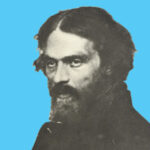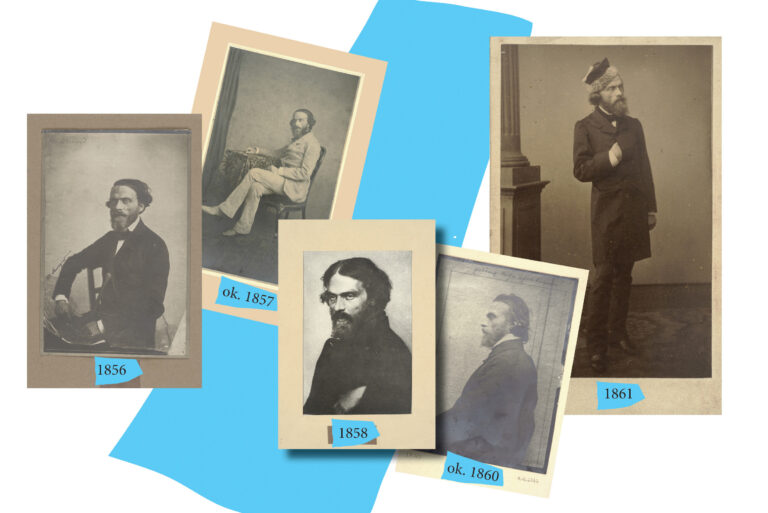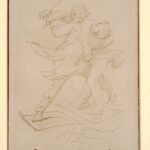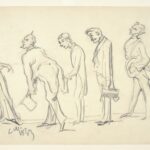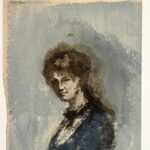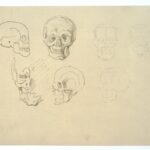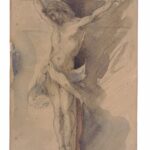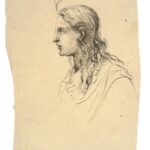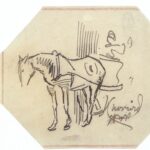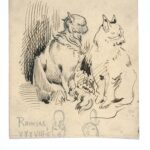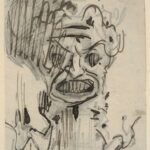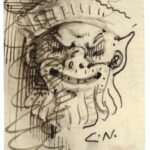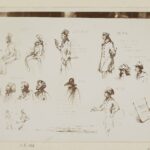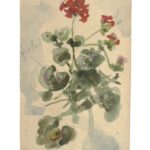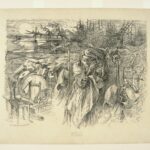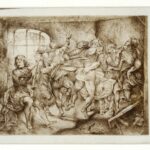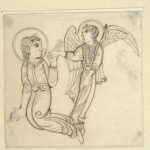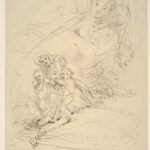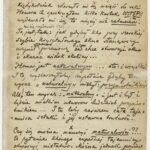Orphanhood
When he was less than five years old, on April 11, 1825, his mother Ludwika, née Zdzieborska Norwid (1798-1825) died, orphaning him and his three siblings: Ludwik, Paulina, and Ksawery. Ten years later, on July 25, 1835, the family’s father, Jan Norwid (1785-1835), died. The orphaned children were taken care of by relatives on the mother’s side. They formed a family council for the benefit of the minor children, consisting of the following persons: the Dybowski family from Dębinek in Mazovia (especially their grandmother Anna Dybowska, who after the death of her first husband from the Zdzieborski family married Ksawery Dybowski from Dębinek), the Sobiescy family (coat-of-arms Janina) from the noble branch of the Sobieski family, who settled in Mazovia and were distantly related to the royal Sobieski line.
His great-grandmother Wiktoria Hilaria of Buyn Sobieska (1761-1830) was particularly influential in Cyprian’s upbringing. She introduced him to Latin Christianity as a family-Church, in which there is ultimately no room for orphanhood (cf. his youthful poem Orphans). With time, the sense of orphanhood was extended in Norwid’s views to entire generations, those born around 1820 who as children survived the catastrophe of the November Uprising, the subsequent emigration of thousands of defeated countrymen from the Kingdom of Poland, the failed and often tragic Warsaw youth conspiracies, and others (e.g. in Siedlce or Łuków). These experiences are accompanied by a sense of solitude in the hopeless conspiracy and ruthless pressure from the invaders, as well as by imprisonment, exile (Siberia), forced conscription into the Russian army, and often fatal sentences, such as the public execution of Artur Zawisza and his associates on the Warsaw turnpike on November 26, 1833.
Crises in Norwid’s life
Norwid was able to transfer crises into a parabolic dimension, changing their value (cf. the situations depicted in the poems Sphinx, Fatum, Run with God, and Chopin’s Piano, for example).
In a poetic summary of his situation as an “emigrant from exile,” i.e., his escape to America in late 1852, he used the poignant image of the “over-complete actor”
As for me, the thing is different: I am
In the world as in a perfect troupe
An over-complete actor – if once
A place will make for me by somebody’s cold,
That’s good – or if a lover is late,
Or a ghost’s puts hair out of place not on time
Or lightning should strike a passerby…
These are my specialties in a drama!
(a poem from 1853 sent from New York to Maria Trębicka: I 217)
Life in earnest
A deep critical sense contributed to taking life seriously, but Norwid also possessed the ability to discover in “ordinary” cases and experiences a symbolic or parabolic perspective, which allowed him, among other things, to transfer the experience of exile into a moral and political dimension and to define the historical mission of Polish exile as a constant remorse for Europe and even for the Vatican. This can be seen very well when Norwid’s trip to the West, from a kind of artistic and sightseeing adventure (traveling around Europe in 1842-1846), quite quickly began to turn into an acute series of personal and public disasters.
The climax came when he was forced into political emigration (a consequence of his stay in a Prussian prison after refusing to cooperate with the Russian authorities – VI/VII 1846). Here it is worth recalling the poet’s reaction to the temptation of tsarist amnesty for Polish emigrants after the defeat in the Crimean War (a May 1856 decree of Nicholas I’s successor – Tsar Alexander II):
“… the boundaries of nations that are borderless are the characters of the people […]. And Poles grasping for amnesty, if they do not see that Russia gives only presence [here: minimum of temporary existence – note J. F.], forbidding the past and future, that is – that it does not give anything, because every moment of life is a continuous past and future, and every today is still yesterday and tomorrow…, if they do not see this, they will carry their own characters to waste, cheating Russia, France, Poland and themselves”.
(from a letter to K. Górska, early 1857, VIII 302-303)
The importance of work
Personal circumstances and the extraordinary perspicacity of a brilliant mind also forged his conviction of the importance of self-reliance in life, that is, the obligation to secure one’s livelihood through one’s own work in the broadest sense of the word – from respectable manual labor, such as laying street paving, to work done by “workers of truth,” as seen in his summary of his “expedition to America” in 1852-1854:
“For my part, I make no secret of the fact that, though well paid, I did not return by no means as a capitalist, having lifted so much in profit, that great journeys, as far as could be usefully done, with my pencil supporting myself, I accomplished”
(from a letter to Adam Potocki, second half of 1855; VIII 245)
or in his assessment of the contemporary exploitation of workers:
“…whoever has come into contact with the world of Parisian work must reckon with every moment as I do – otherwise he will make a nuisance of himself and others […] there are two kinds of workers who are both harmful to the truth: the first – those who cannot have enough humility and order to do something for money; the second – who only do energy and patience for money […] bringing only chaos, which is the elementary despotism”.
(from a letter to Mieczysław Pawlikowski, 15 October 1855, VIII 248)
Literary salons
Literary salons, along with Warsaw’s press (literary criticism), influenced Norwid’s debut and his initial popularity as a poet, reciter, and member of the social elite (Edward Dembowski even called him “the star of Warsaw’s young literati”). They were also decisive for his attachment to an intimate model of cultural life. This was also how he functioned in exile (the salons of the Polish community in Rome and Paris, the salons of artists and the French elite).
It is worth noting the ambivalent assessment of this form of cultural life – both in the poet’s own feelings and in the opinions of literary critics.
“Salon familiarity” remained with him throughout his life in his manner of being or social relations, such as the custom of entering among people in appropriate attire, including the obligatory gloves, cylinder, etc.
Great loves or the one and only?
An attempt to understand the place of Maria Kalergis and other women
in Norwid’s life, his literary and artistic achievements
The theme of love and its sublimation in Norwid’s work is one of the most important components of his writings and “biographical legend,” and remains intriguing to this day. However, one must not succumb to the temptation of a too straightforward approach to the literary and artistic transformations of the heroines of Norwid’s “amorous adventures.
For all the “romanticism” of the subject, it is worth noting Norwid’s conceptualization – very modern, sometimes even “feminist” – of the then burning “women’s question. An example is his diagnosis of the fate of those cultures that “observe” an oppressive attitude towards women:
“[…] I think Islamism should rather be regarded as the extreme Christian sect that has become a religion. […] the woman question, it seems to me, is the Achilles’ heel – and just as old republic of Poland toppled over the peasant question, so Islam will topple over the woman question…. […]”
(from a letter to Mieczysław Geniusz, September 29, 1977, X 101 n.)
Friendships and acquaintances, failures and disappointments,
brotherhood and alienation
Despite his legend of abandonment and loneliness, Norwid knew many truly outstanding people of his time, both at home and abroad, as well as outstanding foreign artists. Sometimes these acquaintances turned into important relationships, sometimes powerfully influencing the poet’s fate.
Novelty (distinctiveness) of poetry and art
Look, I say, to this land, to which my pupils
I, Raphael – gave back – who in the Lord’s Name
I conquered the old Olympus – the Muses courting,
Nymphs, Graces I gathered in pre-Christian Rome –
And I passed through – not with the inquisition’s flaws
I passed: and not by any curse of the Inquisition,
But with victory only – with free bloom,
Like Columbus, I discovered the world, trusting in tradition.
C. Norwid: The Conversation of the Dead: Byron, Raphael-Sanzio (PWsz I 281)
Norwid’s approach to tradition and the present is a distinctive feature of his artistic and literary program. This original, “own” way of viewing the place of the writer and artist in the history of culture earned him on the one hand – especially among his contemporaries – the stigma of the “incomprehensible” and “dark” poet, and even the sometimes absurd charge of not knowing the Polish language. On the other hand – especially since his great “return” at the beginning of the 20th century – he has been considered a brilliant innovator and revelator in the field of poetic language and literary program. It is worth remembering, looking at Norwid’s “popularity” today among his “late grandchildren”, that this truly outstanding artist chose his “thorny path” to cultural prominence with full awareness, and although his friends repeatedly urged him to “lower his flights”, he remained faithful to his vision of “future art in Poland”.
Parallel to Norwid’s dramatic rejection as a poet, we observe from the beginning of his journey a clear appreciation for his artistic works (mostly prints), which can be seen not only in the poet’s closest circles, but also on the European forum. It is worth remembering, however, that this was not a “fame” comparable to that of the most famous artists of his time, for in this field Norwid did not hesitate to take a separate, “unfashionable” stance, and often harshly commented on those tendencies in art that set the tone of the time, such as Impressionism in painting or Parnassianism in poetry.
The dominant feature of Norwid’s work is a kind of “historicism.” This should have brought him closer to one of the most important ideas of the nineteenth century, yet in this area Norwid also “squared off” with his contemporaries. The historicism of the author of Quidam carries an enormous intellectual charge, and is often closer to “historical studies” than to “fashionable” historiosophy or historical fantasies. This is one of the reasons for the growing conflict between Norwid and his contemporaries, particularly with Zygmunt Krasiński and Józef Kraszewski.
One of the most interesting components of Norwid’s “program” is summarized in his key notion of dialogue as a multi-faceted method of meeting people on their way to truth. Yet the context of artistic “superiority” proved to be an unbreakable stereotype – his contemporaries preferred to burden the poet with a thousand accusations, including the accusation that he deliberately “ran after darkness,” rather than take up the Socratic challenge (often provocative and saturated with irony) in dialogue with Norwid. In a fragment of a poem from 1845, when the poet was still surrounded by an aura of “good fortune”, he ironically described his “vision” of his “career”
And popularity to have among the crowd,
And anecdotes about the tenderness of the heart,
Which once upon a time with rhetorical noise
Were taught in schools, wishing to teach virtues;
And the new Plutarch – poured into new lives ….
C. Norwid: In the diary of L. A. Improvisation (PWsz I 73)
It is also worth taking a look at Norwid’s approach to language as a literary material – he is faithful to his epoch in this field, in his search for significant content in the study of language as the foundation of being (a traditionalist approach), and on the other hand – as the most important manifestation of national identity, whose highest emanation is the masterpieces created in language; a clear declaration of this approach can be found in the poem from the collection Vade-mecum – National language:
Not a sword, not shields are the weapons of Language,
But – masterpieces!
Contemporary art critics recognized Norwid’s outstanding talent as a sketch artist, comparing him to the achievements of the most eminent European artists (such as Dürer, Raphael, and Rembrandt). In Norwid’s artistic works we find the same imperative as in his literary achievements – the paramount importance of meaning (significance, intellectual and moral message) in artistic expression, hence the importance of the symbol as the most succinct carrier of content (cf. Solo prints, Unnecessary Musician).
Norwid’s highly critical approach to Impressionism, which entered the art world, may seem surprising. With time, this particular trend, despite its initial “rejection” by contemporary aesthetic salons, took center stage in European culture. Norwid was discouraged by its focus on the “technique” of rendering color impressions, while completely ignoring an intellectual view of the world. One could say that he was offended by the dominance of the “analytical” approach (the artist’s focus on capturing the transience of constantly changing colors) over the “synthetic” one – the search for meaning as a consequence of being.
Looking at Norwid’s “divergence” from contemporary art of his time from today’s perspective, one can point to the paths taken by the twentieth-century successors to impressionism or Parnassianism: Picasso’s abstractionism, symbolism in the achievements of modernism, and so on.
Norwid’s innovative approach to the “tasks” of art can be seen in a certain, constantly recurring tendency – to associate beauty with utility (e.g., in the idea of caring for the beauty of everyday objects).
Norwid’s particularly important message for future generations may be considered to be his fight for the recognition of art as one of the most important goods of man as a creator and active consumer of beauty, who through beauty comes closer to Transcendence:
And this is how I see the future art in Poland,
As a flag on a tower of human works,
Not as a toy nor as a science,
But as the highest craft of the apostle
And like the lowest prayer of an angel.
C. Norwid: Promethidion (NDW IV 108, 116)
Źródła rycin: Biblioteka Narodowa (polona.pl), sygnatury: F.358 (Polemika XIX w.), R.579 (Karykatury), R.547 (Oświadczyny), R.563 (Studium portretowe młodej kobiety), R.624 (Studia czaszki ludzkiej), R.707 (Chrystus na krzyżu), R.738 (Popiersie młodej kobiety z gwiazdą nad czołem), R.812 (Koń w zaprzęgu), R.835 (Koty), R.848 (Maszkaron), R.847 (Maszkaron uśmiechnięty), F.183/norwidiana (Europa, typy charakterystyczne), R.801 (Pelargonie), G.4420 (Solo), F.14859 (Muzyk niepotrzebny), R.2126 (Św. Mateusz Ewangelista ze swoim atrybutem, aniołem), R.569 (Anioł stróż), Rps 6317 II (Przekład fragmentów Odysei Homera).

